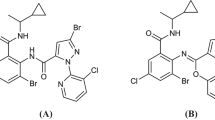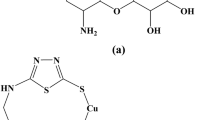Abstract
Emamectin benzoate (EB), chlorantraniliprole (CTP), chlorfenapyr (CFP), and lufenuron (LFR) are widely used to control Spodoptera exigua on cabbage. This study is aimed at establishing a universal, sensitive, accurate, and efficient method for the determination of these pesticide residues in cabbage using QuEChERS pretreatment combined with ultra-performance liquid chromatography or gas chromatography-tandem mass spectrometry (UPLC‒MS/MS or GC‒MS/MS). The recoveries of these pesticides (containing metabolites) in cabbage detected by the optimized method ranged between 80.9% and 99.9%, with relative standard deviations (RSDs) of 0.164–12.5%. The limit of quantification (LOQ) of the four pesticides was determined to be 0.01 mg/kg. The standard curve, accuracy, precision, and LOQ of the analysis method all met the requirements of pesticide residue detection. The optimized method was used to detect the dissipation dynamics and terminal residues in 12 regions. The dissipation half-lives of CTP, CFP, and LFR were 3.35–7.01 d, 2.29–4.75 d, and 3.24–6.80 d, respectively. The terminal residues of all these pesticides were below the maximum residue limits (MRLs). The dietary risk assessment indicated that the dietary risk probabilities for EB, CTP, CFP, and LFR were all less than 1 and were within the acceptable range. This study provides a comprehensive assessment of the residues and dietary risks of EB, CTP, CFP, and LFR for the scientific use of pesticides.
Graphical Abstract




Similar content being viewed by others
Data availability
All the data are available from the corresponding author when required.
References
Ahlawat S, Gulia S, Malik K, Rani S, Chauhan R (2019) Persistence and decontamination studies of chlorantraniliprole in Capsicum annum using GC-MS/MS. J Food Sci Technol 56:2925–2931. https://doi.org/10.1007/s13197-019-03757-y
Ali Abd El-Rahman H, Omar AR (2022) Ameliorative effect of avocado oil against lufenuron induced testicular damage and infertility in male rats. Andrologia 54:e14580. https://doi.org/10.1111/and.14580
Bletsou A, Hanafi AH, Dasenaki ME, Thomaidis NS (2012) Development of specific LC-ESI-MS/MS methods to determine bifenthrin, lufenuron, and iprodione residue levels in green beans, peas, and chili peppers under Egyptian field conditions. Food Anal Methods 6:1099–1112. https://doi.org/10.1007/s12161-012-9515-2
Chen X, Zheng J, Teng M, Zhang J, Qian L, Duan M, Zhao F, Zhao W, Wang Z, Wang C (2021) Bioaccumulation, metabolism and the toxic effects of chlorfenapyr in zebrafish (Danio rerio). J Agric Food Chem 69:8110–8119. https://doi.org/10.1021/acs.jafc.1c02301
Cheng X, Xiao J, Liu Y, Gao Q, Fang Q, Liao M, Liang B, Hu Z, Cao H (2022) Effect of formulation on the indoxacarb and lufenuron dissipation in maize and risk assessment. Environ Sci Pollut Res 29:70976–70983. https://doi.org/10.1007/s11356-022-20719-8
Deng L, Chen L, Guan S, Liu J, Liang J, Li X, Li Z (2020) Dissipation of emamectin benzoate residues in rice and rice-growing environments. Molecules 25:483. https://doi.org/10.3390/molecules25030483
Ditya P, Das SP, Sarkar PK, Bhattacharyya A (2010) Degradation dynamics of chlorfenapyr residue in chili, cabbage and soil. Bull Environ Contam Toxicol 84:602–605. https://doi.org/10.1007/s00128-010-9994-z
Dong B, Zhao Q, Hu J (2015) Dissipation kinetics of emamectin benzoate and lufenuron residues in cabbage grown under field conditions. Environ Monit Assess 187:765. https://doi.org/10.1007/s10661-015-4989-1
Fang L, Zhang S, Chen Z, Du H, Zhu Q, Dong Z, Li H (2015) Risk assessment of pesticide residues in dietary intake of celery in China. Toxicol Pharm 73:578–586. https://doi.org/10.1016/j.yrtph.2015.08.009
Fanigliulo A, Sacchetti M (2009) Emamectin benzoate: new pesticideagainst Helicoverpa armigera. Commun Agric Appl Biol Sci 73:651–653
Go SH, Lee DH, Na SI, Park JH (2022) Analysis of growth characteristics of kimchi cabbage using drone-based cabbage surface model image. Agriculture 12:216. https://doi.org/10.3390/agriculture12020216
He M, Song D, Jia HC, Zheng Y (2016) Concentration and dissipation of chlorantraniliprole and thiamethoxam residues in maize straw, maize, and soil. J Environ Sci Health Part B 51:594–601. https://doi.org/10.1080/03601234.2016.1181903
Hicks MB, Payne LD, Prabhu SV, Wehner TA (1997) Determination of emamectin benzoate in freshwater and seawater at picogram-per-milliliter levels by liquid chromatography with fluorescence detection. J Aoac Int 80:1098–1103. https://doi.org/10.1093/jaoac/80.5.1098
Ishaaya I, Kontsedalov S, Horowitz AR (2002) Emamectin, a novel pesticidefor controlling field crop pests. Pest Manag Sci 58:1091–1095. https://doi.org/10.1002/ps.535
Jia G, Zeng L, Zhao S, Ge S, Long X, Zhang Y, Hu D (2018) Monitoring residue levels and dietary risk assessment of pymetrozine for Chinese consumption of cauliflower. Biomed Chromatogr 33:e4455. https://doi.org/10.1002/bmc.4455
Jyot G, Mandal K, Chahil GS, Singh B (2014) Persistence and risk assessment of emamectin benzoate residues on okra fruits and soil. Environ Technol 35:1736–1743. https://doi.org/10.1080/09593330.2014.881420
Kianmatee S, Ranamukhaarachchi SL (2007) Combining pest repellent plants and biopesticides for sustainable pest management in Chinese kale. J Asia-Pacific Entomol 10:69–74. https://doi.org/10.1016/s1226-8615(08)60333-7
Koesukwiwat U, Sanguankaew K, Leepipatpiboon N (2014) Evaluation of a modified QuEChERS method for analysis of mycotoxins in rice. Food Chem 153:44–51. https://doi.org/10.1016/j.foodchem.2013.12.029
Krogh KA, Bjorklund E, Loeffler D (2008) Development of an analytical method to determine avermectins in water, sediments and soils using liquid chromatography-tandem mass spectrometry. J Chromatogr A 1211:60–69
Lee J, Kim BJ, Kim E, Kim J-H (2019) Dissipation kinetics and the pre-harvest residue limits of acetamiprid and chlorantraniliprole in kimchi cabbage using ultra-performance liquid chromatography-tandem mass spectrometry. Molecules 24:2616. https://doi.org/10.3390/molecules24142616
Li H, Sun F, Hu S, Sun Q, Zou N, Li B, Mu W, Lin J (2022a) Determination of market, field samples, and dietary risk assessment of chlorfenapyr and tralopyril in 16 crops. Foods 11:1246. https://doi.org/10.3390/foods11091246
Li K, Chen W, Deng P, Luo X, Xiong Z, Li Z, Ning Y, Liu Y, Chen A (2022b) Dissipation, residues and risk assessment of lufenuron during kumquat growing and processing. J Food Compost Anal 112:104643. https://doi.org/10.1016/j.jfca.2022.104643
Lin H, Dong B, Hu J (2017) Residue and intake risk assessment of prothioconazole and its metabolite prothioconazole-desthio in wheat field. Environ Monit Assess 189:236. https://doi.org/10.1007/s10661-017-5943-1
Liu S, Zhang F, Wang L, Pan C (2012) Dissipation and residues of emamectin benzoate in cabbage. Environ Contam Toxicol 89:654–657. https://doi.org/10.1007/s00128-012-0729-1
Liu C, Lu D, Wang Y, Huang J, Wan K, Wang F (2013) Residue and risk assessment of pyridaben in cabbage. Food Chem 149:233–236. https://doi.org/10.1016/j.foodchem.2013.10.085
Matuszewski BK, Constanzer ML, Chavez-Eng CM (2003) Strategies for the assessment of matrix effect in quantitative bioanalytical methods based on HPLC-MS/MS. Anal Chem 75:3019–3030. https://doi.org/10.1021/ac020361s
Paramasivam M, Karthik P, Muralitharan V (2022) Dissipation, decontamination, dietary and ecological risk assessment of chlorantraniliprole in chilli fields. Toxicol Environ Chem 104:293–306. https://doi.org/10.1080/02772248.2022.2130313
Patra S, Ganguly P, Barik SR, Samanta A (2018) Dissipation kinetics and risk assessment of chlorfenapyr on tomato and cabbage. Environ Monit Assess 190:7. https://doi.org/10.1007/s10661-017-6457-6
Santana-Mayor Á, Socas-Rodríguez B, Herrera-Herrera AV, Rodríguez-Delgado MÁ (2019) Current trends in QuEChERS method. A versatile procedure for food, environmental and biological analysis. Trends Analyt Chem 116:214–235. https://doi.org/10.1016/j.trac.2019.04.018
Singh B, Kar A, Mandal K, Kumar R, Sahoo SK (2012) Development and validation of QuEChERS method for estimation of chlorantraniliprole residue in vegetables. J Food Sci 77:208–215. https://doi.org/10.1111/j.1750-3841.2012.02801.x
Thavarajah D, Thavarajah P, Abare A, Basnagala S, Lacher C, Smith P, Combs GF (2016) Mineral micronutrient and prebiotic carbohydrate profiles of USA-grown kale ( Brassica oleracea L. var. acephala ). J Food Compos Anal 52:9–15. https://doi.org/10.1016/j.jfca.2016.07.003
Valese AC, Molognoni L, de Souza NC, de Sá PLA, Costa ACO, Barreto F, Daguer H (2017) Development, validation and different approaches for the measurement uncertainty of a multi-class veterinary drugs residues LC-MS method for feeds. J Chromatogr B 1053:48–59. https://doi.org/10.1016/j.jchromb.2017.03.026
Van LT, Stillatus V, Tirry L (2004) Genetic analysis and cross-resistance spectrum of a laboratory-selected chlorfenapyr resistant strain of two-spotted spider mite (Acari: Tetranychidae). Exp Appl Acarol 32:249–261. https://doi.org/10.1023/b:appa.0000023240.01937.6d
Wang R, Liu B, Zheng Q, Qin D, Luo P, Zhao W, Ye C, Huang S, Cheng D, Zhang Z (2021) Residue and dissipation of two formulations of emamectin benzoate in tender cowpea and old cowpea and a risk assessment of dietary intake. Food Chem 361:130043. https://doi.org/10.1016/j.foodchem.2021.130043
Zhang D, Tang J, Zhang G, Wu X, Sun Q, Jia C, Hua R (2021) Deposition, dissipation, metabolism and dietary risk assessment of chlorothalonil in open field-planted cabbage. J Food Compos Anal 102:104008. https://doi.org/10.1016/j.jfca.2021.104008
Zou L, Yu B, Ma X, Cao B, Chen G, Chen C, Lei J (2019) Cloning and expression analysis of the bocmbf1c gene involved in heat tolerance in Chinese kale. Int J Mol Sci 20:5637. https://doi.org/10.3390/ijms20225637
Funding
This work was supported by the Ningxia Hui Autonomous Region Key Research and Development Programs (2022BBF02012), the Central Government Guides of the Local Science and Technology Development Fund Projects (YDZX2022155), Science and Technology Innovation Development Project of Tai’an (2021NS315), Provincial Innovation and Entrepreneurship Training Program for College Students in Shandong Province (S202210434018S, S202210439018, and S202210439030), and the Young Elite Scientists Sponsorship Program by CAST (2022QNRC001).
Author information
Authors and Affiliations
Contributions
XW: completion of the experiments and draft writing. SH and LM: completion of the material characterization section and data analysis. KW and XZ: processing of experimental data. KL and NW: processing of figures and tables in the manuscript. NZ and YX: modification of the manuscript and response to reviewers. XP, BL, and WM: design and guidance of research.
Corresponding author
Ethics declarations
Ethics approval
Not applicable.
Consent to participate
Consent is not applicable as the study did not include human subject.
Consent for publication
All the authors approved and confirmed this submission.
Competing interests
The authors declare no competing interests.
Additional information
Responsible Editor: Ester Heath
Publisher's Note
Springer Nature remains neutral with regard to jurisdictional claims in published maps and institutional affiliations.
Supplementary Information
Below is the link to the electronic supplementary material.
Rights and permissions
Springer Nature or its licensor (e.g. a society or other partner) holds exclusive rights to this article under a publishing agreement with the author(s) or other rightsholder(s); author self-archiving of the accepted manuscript version of this article is solely governed by the terms of such publishing agreement and applicable law.
About this article
Cite this article
Wang, X., Hu, S., Meng, L. et al. Residue dissipation dynamics and dietary risk assessment of emamectin benzoate, chlorantraniliprole, chlorfenapyr, and lufenuron in cabbage. Environ Sci Pollut Res 30, 121748–121758 (2023). https://doi.org/10.1007/s11356-023-30919-5
Received:
Accepted:
Published:
Issue Date:
DOI: https://doi.org/10.1007/s11356-023-30919-5




